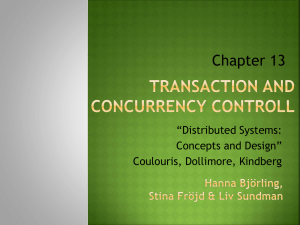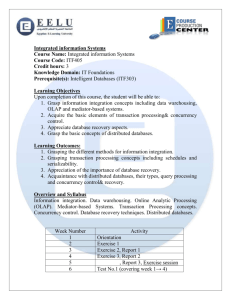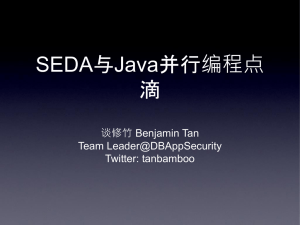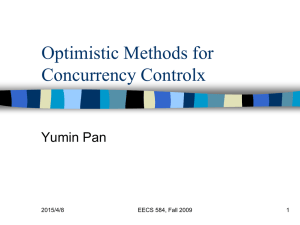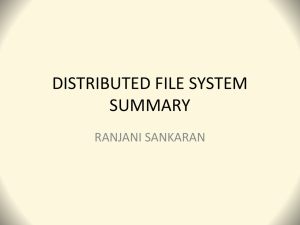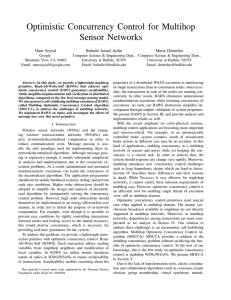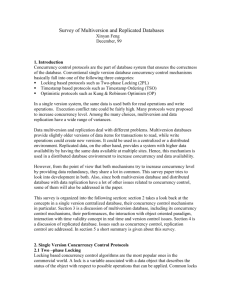Lecture for Chapter 6.3 (Fall 09)
advertisement
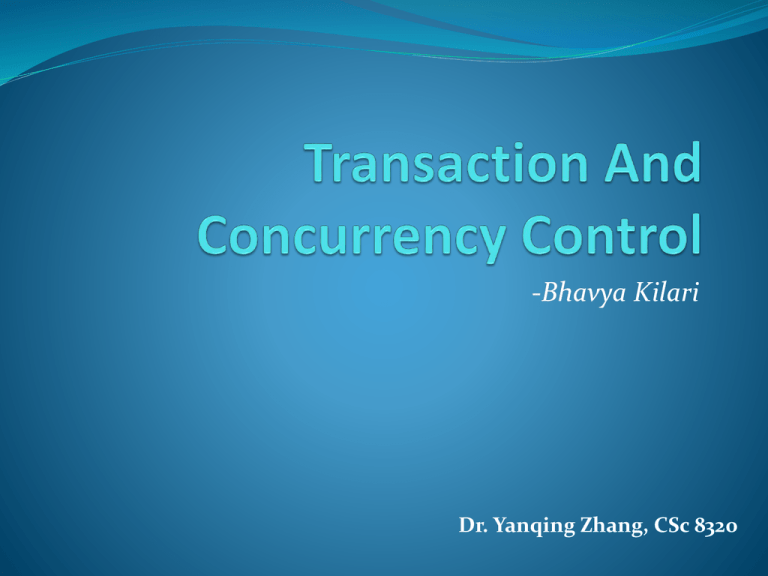
-Bhavya Kilari
Dr. Yanqing Zhang, CSc 8320
PREVIEW
PART I: INTRODUCTION
o Transaction Processing System [R. Chow & T. Johnson, 1997]
o Serializability [M. Duckett, 1995]
o Concurrency Control Protocols
PART II: CURRENT RESEARCH
o
o
ZODB[zope cor, Wikipedia, 2009]
Muntiversion Concurrency Control (MVCC)
PART III: FUTURE POTENTIAL
o RWC [Andrews,2009]
o Dynamic Switching
REFERENCES
Transaction Processing
Motivation : to make use of clean and powerful
atomic transaction semantics (ACID Properties)
Atomicity
All or None - Two-Phase Commit
Indivisible – SCH Concurrency Control Protocol
Atomic update – OM Replica Management
Transaction Processing System[1]
o Client Process:
Issue a begin transaction
Is at liberty to abort Tr anytime
Issues end transaction
o Transaction Manager (TM)
Creates TID and work space
Access request to data object carries TID sent to scheduler
Rejection causes TM to send abort to the client and other
TMs
COMMIT must be atomic: two phase commit protocol
o Scheduler (SCH)
Chooses a concurrency control protocol to ensure
consistency
Inconsistency can be prevented or avoided or consistency
can be validated
o Object Manager (OM)
Interfacing with underlying file service
Consistency of replicas using replica management protocol
Cache management for efficiency and failure recover for
durability.
Serializability
Schedule: set of actions of transactions
Serial Schedule: serial execution of actions of set of
transactions
Serializable schedule:
Serializability ensures consistency
Conflicts: write-write, read-write or write-read
Example
Serial schedule : {t1,t2}, {t2,t1} t0 COMMITED
Possible results {C,D} : {80,120}, {120,80}
Operation pairs {1,3} & {2,4} – write-write conflict
Concurrency Control Protocols[1]
o Two-Phase Locking
o Timestamp Ordering
o Optimistic Concurrency Control
Dining Philosophers Problem[4]
“Common computing problem in concurrency”
Solutions
Waiters Solution
Resource hierarchy solution
CURRENT RESEARCH
Zope Object Database(ZODB) [9,10]
Object-oriented database for transparently and
persistently storing objects
Features of the ZODB include: transactions,
history/undo, transparently pluggable storage, built-in
caching, multiversion concurrency control (MVCC),
and scalability across a network (using ZEO).
Speed , ease of use and administration
Multiversion Concurrency Control[2,3]
Each user connected to the database with a snapshot
Changes seen by other users only after the transaction
COMMITS
MVCC uses timestamps or increasing transaction IDs
to achieve serializability
Microsoft SQL Server,MySQL,Oracle,Sybase SQL etc
uses MVCC
FUTURE POTENTIAL
Concurrency Control
Mechanisms[3]
Basic criteria:
Degree of Concurrency provided
2. Potential for deadlocks
3. Level of Consistency guaranteed
1.
Design Of Concurrency Control
Mechanisms-RWC [6]
Read-write-certify (RWC)
FURTHER IMPROVEMENT
New Proposal[5]
Dynamically switching between different types of
concurrency control techniques to provide an adaptive
access strategy[5]
REVIEW
TPS AND ITS COMPONENTS
SERIALIZABILITY
CONCURRENCY CONTROL
LATEST TECHNIQUES (Zope ODB, MVCC)
REFERENCES
[1]Distributed Operating Systems and Algorithm
Analysis, Andy Chow & Theodore Johnson,1997
[2]Wikipedia
[3]Bernstein, Philip A. and Goodman, Nathan
(1981), Concurrency Control in Distributed Database
Systems, ACM Computing Surveys
[4]Chandy, K.M.; Misra, J. (1984). The Drinking
Philosophers Problem. ACM Transactions on
Programming Languages and Systems.
[5]http://www.patentstorm.us/patents
[6]http://blogs.cs.st-andrews.ac.uk/angus/2009/09/
[7]A. S. Tanenbaum, “Distributed Operating
Systems”,Prentice Hall, pp.22-25,2001.
[8] “The Two-Phase Commit Protocol”, Mike Duckett,
http://ei.cs.vt.edu/~cs5204/
sp99/distributedDBMS/duckett/tpcp.html, 4-30-1995.
[9]http://en.wikipedia.org/wiki/Zope_Object_Database
[10] http://www.zope.org/
QUERIES??
